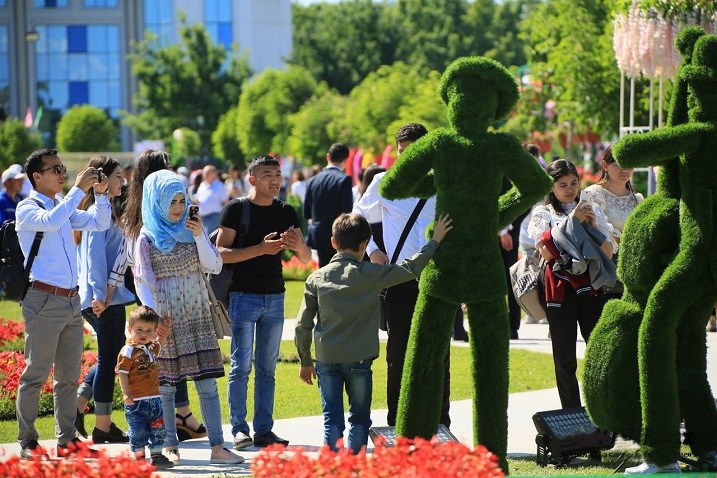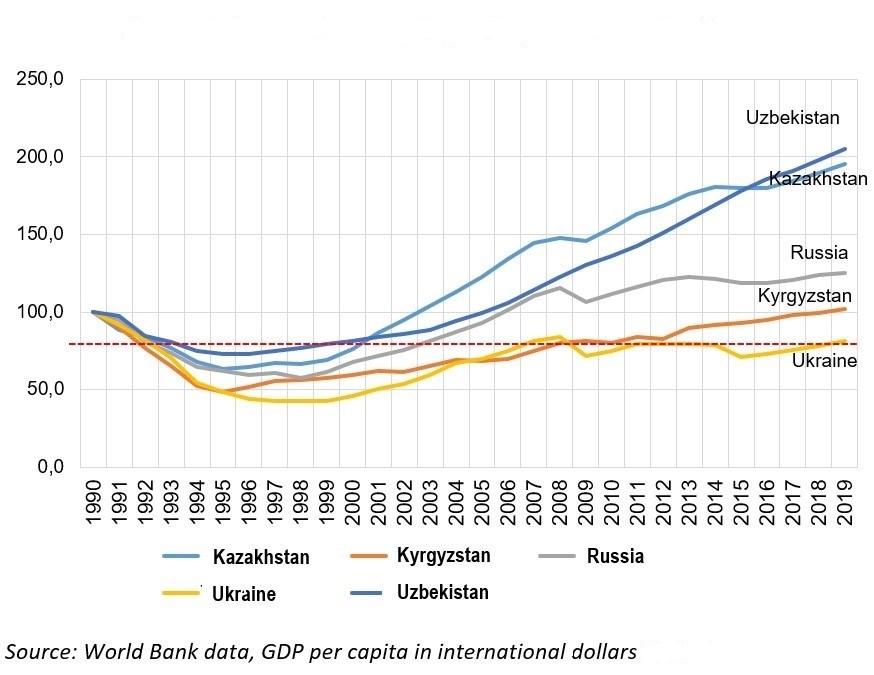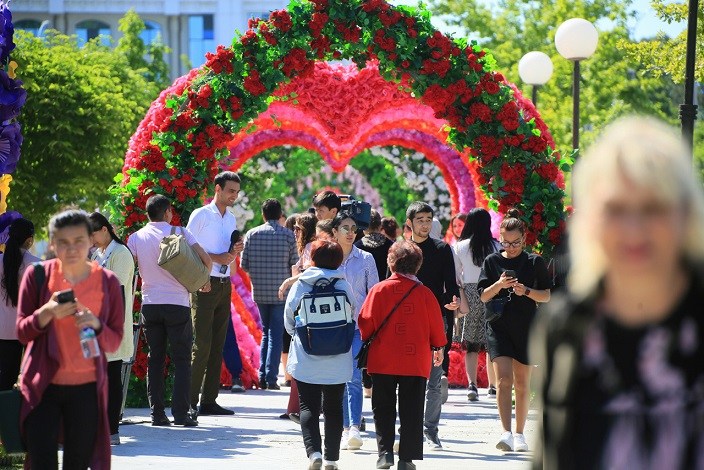Promoted by the Embassy of Uzbekistan in Brussels. The views belong to the sponsor.
Independent Uzbekistan celebrates its 30th anniversary this year. On the eve of gaining independence, the country’s economy was far from successful, and the standard of living was low. In 1990, the national income per capita in Uzbekistan was two times lower, labour productivity in industry lagged behind by 40% and 50% of agriculture was from the Union average. The average per capita income was less than 75 rubles. With the collapse of the USSR, economic ties began to break, production fell and the low standard of living and social protection was rapidly declining.
In these difficult conditions, Uzbekistan developed its own model, transition to market relations, which was based on five principles: the economy takes precedence over politics, the state acts as the main reformer, the rule of law, strong social protection and reforms carried out in stages. According to a UNDP study in the mid 2000s, Uzbekistan was the first post-Soviet country to stop the decline in production and move to economic growth. The decline in production in Uzbekistan was the lowest among the post-Soviet countries and the level of social protection was higher than in other post-Soviet countries. While other post-Soviet countries were losing entire industries, new industries were created in Uzbekistan.
New reforms
However, it must be admitted that by the mid-tenths, the development of the Uzbek economy began to slow down due to too strict administrative regulation, which did not allow the full use of the potential of market incentives for its development. In this regard, the new President of Uzbekistan, elected in 2016, Shavkat Mirziyoyev, began a new stage of reforms in all spheres of life.
In February 2017, he approved the Action Strategy for the five priority areas of development of Uzbekistan during 2017-2021. Key areas of the new stage: improving state and social construction, ensuring the rule of law and reforming the judicial and legal system, developing and liberalising the economy, developing the social sphere, ensuring security, implementing a balanced and constructive foreign policy. In all these areas, important steps have been taken in recent years.
In September 2017, a presidential decree "On the liberalisation of foreign exchange policy" was issued, which allowed legal entities and individuals to freely convert currency. Up to this point, currency exchange operations were a big problem, as there were three different rates: the black market, the stock exchange rate and the central bank rate.
Another key economic reform was the tax reform, the main stage of which was completed in 2020 with the introduction of the new Tax Code. Numerous administrative issues for entrepreneurial activity were eliminated and as a result the rating of the republic improved by 7 positions in the Doing Business 2020 report of the World Bank. Uzbekistan ranked 69th place, which allowed the country to enter the list of the top 20 reformers. And in the Index of Economic Freedom 2020, produced by the Heritage Foundation in conjunction with The Wall Street, Uzbekistan improved its result by 26 positions, moving up from 140th place to 114th place.
At the present stage of reforms, much attention is paid to integration into the world economy. In 2020, it was possible to achieve an early decision of the European Commission to grant Uzbekistan the status of a beneficiary of the general system of preferences GSP+, which allows duty free supply of more than 6 thousand domestic products to the European market.
Currently, there are 22 free economic zones in the country, Uzbekistan has become an observer in the EAEU and an active discussion is underway on the country's accession to the WTO.
Structural changes in the economy
If we talk about the economic indicators of Uzbekistan since the independence, during 1990-2019, Uzbekistan's GDP in current prices increased by $40.3 billion (3.3 times) to $57.9 billion. In 2020, despite the pandemic, the economy of Uzbekistan also grew by 1.6% compared to 2019. The average annual GDP growth in Uzbekistan was at the level of $1.4 billion or 4.2%. Over the same period, GDP per capita in Uzbekistan increased by $890.0 (2 times) to $1,756.0.
According to the World Bank, in 2019, GDP per capita in terms of purchasing power in Uzbekistan reached $7,000. In 1991-2019, the average annual growth rate of GDP per capita in Uzbekistan was 4.4%. This is higher than the average growth rates in Kyrgyzstan (3.2%), Moldova (3.6%), Russia (3.1%), Ukraine (2.4%) and Tajikistan (4.0%). In Central Asia, only GDP per capita in Kazakhstan grew faster than in Uzbekistan. But the population of Uzbekistan (average annual growth rate - 1.6%) grew twice as fast as the population of Kazakhstan (0.8%), it can be concluded that Uzbekistan has achieved better results.
Growth index of GDP per capita for the period 1991-2019
During the period of independence, great changes took place in the structure of the Uzbek economy. In the nineties, under the influence of the severance of economic ties in the post-Soviet space, the share of industry in the economy decreased from 25.9% in 1990 to 11.1% in 2000. At the same time, the share of agriculture increased from 33.0% in 1990 to 50.7% in 2000. Later, thanks to the measures taken to develop industrial production, it was possible to radically change this situation. Thus, in general, over the period 1990-2019, the share of agriculture decreased from 33.0% to 27.3%, while the share of industry increased to 29.2%. The share of services in 1990 - 2019 increased from 18.7% to 23.0%.
If in the first decades of reforms in order to provide the economy and the population with the necessary products, the policy of import substitution was carried out, then as the country's industrial potential developed, priority began to be given to the export-oriented approach. In general, during the period 1990-2019 Uzbekistan's exports in current prices increased by $13.8 billion (4.3 times) to $18.1 billion.
The minimum export volume was recorded in 1994 ($2.2 billion) and the maximum in 2019. In connection with the pandemic in 2020, exports have decreased slightly.
The economy of Uzbekistan over the years of independence has turned from an import-substituting agrarian-industrial into an export-oriented industrial-agrarian one. Moreover, in the overall technological structure of the manufacturing industry, the share of high-tech industries is growing. This has already been noted in the ratings of international organizations. Thus, in the Industrial Competitiveness Index 2020 compiled by the UNDP, Uzbekistan was the first to enter the rating, taking 92nd place among 152 countries.
Overcoming transport isolation
The development of transport corridors has huge impact for the development of the economy in Uzbekistan. Moreover, the nature of the borders in Central Asia inherited after the collapse of the Union did not ensure the transport security of a sovereign state, since internal transportations had to be carried out through neighboring countries. New railways and highways laid through high-mountain passes to the Fergana Valley and Surkhandarya region have solved this problem and Uzbekistan has become self-sufficient in terms of transport.
As for external transport, in 1996, new transport corridors were put into operation in the direction of Europe through Iran (the Mashhad-Seraskh-Tejen highway, connecting the railways of Central Asia and Iran) and the Transcaucasus (the trans-Caucasian railroad TRACECA), along which Uzbek cotton and other goods went to Europe. Later, a full-fledged transport corridor was formed to the ports of the Persian Gulf through Iran, which opened the way for Uzbek goods to the countries of South and Southeast Asia.
Now Uzbekistan has reliable transport corridors in all directions: to the Baltic and Russian Far Eastern ports, Chinese ports in the Pacific basin, Iranian ports in the Indian Ocean, and transport links to the European market. A new agenda foresees the implementation of projects of the shortest railway to China through Kyrgyzstan, as well as the construction of transport communications through Afghanistan to Pakistan and India.
In conclusion, it should be said that the dynamic growth of the Uzbek economy, which has been observed in recent years, as well as the economies of other countries, was slowed down by the coronavirus pandemic, but this year it is actively recovering. GDP in the first three months of 2021 increased by 3%. The World Bank predicts that economic growth in Uzbekistan in 2021 and 2022 will reach 4.8% and 5.5%, respectively and the EBRD - 5.6% in 2021 and 6% in 2022. The ongoing economic reforms are already producing a tangible positive effect, which will only intensify in the context of the post-pandemic recovery growth of the world economy.
Dr. Obid Khakimov, Director of the Center for Economic Research and Reforms



